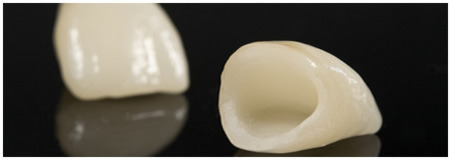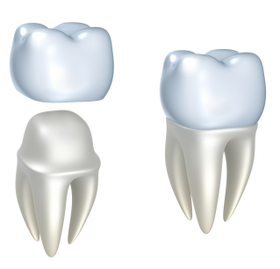
Dental Crowns
If your tooth is damaged but not lost, a crown (also called a cap) can be used to cover the damaged tooth. A heavily restored tooth becomes weak; a crown protects your tooth from further damage.

Dental crowns, what are they?
Crowns can be made of different kinds of metals, porcelain or porcelain fused to metal and sit atop an existing tooth, normally if the tooth has been damaged. They are really strong and last for about 10 years on average, if you take good care of them. Brush and floss your crown, just like you clean your natural teeth.
You may need a crown if:
• You have a root canal;
• You have a large filling in a tooth;
• You have a broken tooth; or,
• Your tooth is badly stained, not the right shape or out of line.
Crowns and replacement teeth may not be as strong as your natural teeth, so:
• Wear a night guard if you clench or grind your teeth at night.
• Do not bite down on hard objects (i.e. forks, bottle caps, etc.)
• Do not use your teeth to open or cut things.
• Do not do these things with your natural teeth either! Or you will be visiting us more often than you may like.
How do we create a crown?
Step 1
Your dentist will take an impression (or mould) of your tooth to fit a temporary crown which protects your tooth until the final, permanent crown is ready. Temporary crowns may not have the same shape and colour as permanent ones.
Step 2
Your dentist will 'freeze' (called a local anaesthetic) your jaw area. He or she then prepares the tooth by filing down the surface layer (approximately 1-2 mm) to make room for the crown.
Step 3
Another impression (or mould) is taken of the filed-down tooth and nearby teeth. Then the temporary crown is temporarily cemented down over your tooth and you are re-appointed to come back a week or two later.
Step 4
This mould is sent to a dental lab, where your permanent crown is custom-made. The mould of your tooth is used to make a model. A restoration that is the same size and shape as your tooth is built based on the model. Your dentist may ask you to visit the dental lab so that they can take a “custom shade” of your tooth (i.e. make the colour match).
Step 5
On your next visit, your dentist takes off the temporary crown and puts on the permanent one. Then he or she checks to make sure the crown is the right fit, shape and colour. If it is, your dentist permenantly cements the crown into place. Your tooth will look and work very much like a natural tooth.
These are the steps dentists most often follow in making a crown, but your tooth may need special care. Prior to placing a crown you may need orthodontic or gum treatment. It may take more than two visits to your dentist or your visits may last longer.